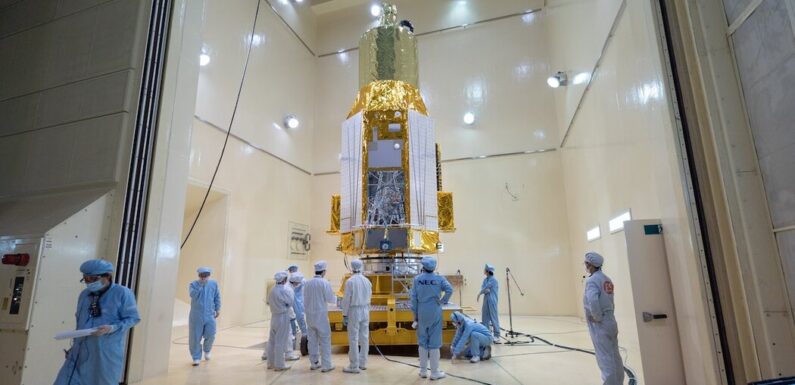
JAXA, the Japanese space agency, is gearing up to launch two very different space missions from one rocket: a new X-ray telescope that will spy on some of the hottest spots in our universe, and a small experimental robotic moon lander.
The telescope is called X-ray Imaging and Spectroscopy Mission, or XRISM for short (pronounced like the word “chrism”). The lunar mission is called Smart Lander for Investigating Moon, or SLIM. Here’s what you need to know about the launch.
When is the launch, and how can I watch it?
XRISM and SLIM are expected to launch from an H-IIA rocket from Japan’s Tanegashima Space Center on Sunday at 8:26 p.m. Eastern time (it will be Monday at 9:26 a.m. in Japan). JAXA is providing a livestream in both Japanese and English on the agency’s YouTube channel starting around 7:55 p.m. Eastern time.
SLIM’s trip to the moon makes the timing tight: There are only a few minutes each day when Earth’s orientation is just right for the spacecraft to get on a trajectory that will put it in lunar orbit. Consequently, JAXA has a reserved launch period through Sept. 15, in case any delays in liftoff cause the mission to miss its launch window.
What is XRISM?
It is a telescope about the size of a bus. JAXA is collaborating with NASA on the mission, with additional participation from the European Space Agency. XRISM will study cosmic X-rays, which unlike other wavelengths of light can only be detected from above Earth’s atmosphere, which shields us from the harmful radiation.
XRISM will use state-of-the-art spectroscopy to measure changes in the brightness of celestial objects at different wavelengths. This data will reveal information on the motion and chemistry of some of the most extreme cosmic locales, like the material swirling around black holes, the blistering plasma permeating galaxy clusters and the remnants of exploding massive stars.
A key tool aboard XRISM is Resolve, an instrument that will collect spectroscopic data with far more resolution than X-ray observatories orbiting the Earth do. Resolve must be cooled to just a fraction above absolute zero in order to measure tiny changes in temperature when X-rays hit the instrument’s surface.
A second instrument named Xtend will operate simultaneously to photograph the cosmos with a resolution comparable to the way our eyes might perceive it if we were to have X-ray vision. While Resolve zooms in, Xtend will zoom out, providing scientists with complementary views of the same X-ray sources over a larger area.
What is SLIM?
SLIM is a compact robotic moon lander with no astronauts aboard. It’s about the size of a small food truck and weighs more than 1,500 pounds at launch.
The lander’s mission is not primarily scientific. Rather, it is to demonstrate a pinpoint navigation system, aiming to set down within about the length of a football field of a targeted landing site. Developing better landing technology would enable future spacecraft to land closer to rugged terrain that is of scientific interest.
Where are XRISM and SLIM going?
The space telescope will be placed in an orbit approximately 350 miles above Earth. Once there, researchers will spend the next few months turning the instruments on and running tests of their performance. Science operations will begin in January, and initial results from this data are expected in about a year.
You’ll have to be patient with SLIM on its trip toward the Shioli crater on the moon’s near side. The spacecraft will be taking a long, roundabout journey of at least four months that requires less propellant. SLIM will take several months to reach lunar orbit, then spend a month circling the moon before attempting to set down on the surface.
Katrina Miller is a science reporting fellow for The Times. She recently earned her Ph.D. in particle physics from the University of Chicago. More about Katrina Miller
Kenneth Chang has been at The Times since 2000, writing about physics, geology, chemistry, and the planets. Before becoming a science writer, he was a graduate student whose research involved the control of chaos. More about Kenneth Chang
Source: Read Full Article